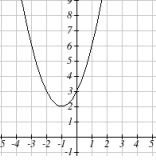Learning Outcomes
- Use the quadratic formula to solve quadratic equations with complex solutions
- Connect complex solutions with the graph of a quadratic equation that does not cross the [latex]x[/latex]-axis
We have seen two outcomes for solutions to quadratic equations; either there was one or two real number solutions. We have also learned that it is possible to take the square root of a negative number by using imaginary numbers. Having this new knowledge allows us to explore one more possible outcome when we solve quadratic equations. Consider this equation:
[latex]2x^2+3x+6=0[/latex]
Using the Quadratic Formula to solve this equation, we first identify a, b, and c.
[latex]a = 2,b = 3,c = 6[/latex]
We can place a, b and c into the quadratic formula and simplify to get the following result:
[latex]x=-\frac{3}{4}+\frac{\sqrt{-39}}{4}, x=-\frac{3}{4}-\frac{\sqrt{-39}}{4}[/latex]
Up to this point, we would have said that [latex]\sqrt{-39}[/latex] is not defined for real numbers and determine that this equation has no solutions. But, now that we have defined the square root of a negative number, we can also define a solution to this equation as follows.
[latex]x=-\frac{3}{4}+i\frac{\sqrt{39}}{4}, x=-\frac{3}{4}-i\frac{\sqrt{39}}{4}[/latex]
In this section we will practice simplifying and writing solutions to quadratic equations that are complex. We will then present a technique for classifying whether the solution(s) to a quadratic equation will be complex, and how many solutions there will be.
In our first example, we will work through the process of solving a quadratic equation with complex solutions. Take note that we will be simplifying complex numbers, so if you need a review of how to rewrite the square root of a negative number as an imaginary number, now is a good time.
Example
Use the Quadratic Formula to solve the equation [latex]x^{2}+2x=-5[/latex].
We can check these solutions in the original equation. Be careful when you expand the squares, and replace [latex]i^{2}[/latex] with [latex]-1[/latex].
| [latex]\begin{array}{r}x=-1+2i\\x^{2}+2x=-5\\\left(-1+2i\right)^{2}+2\left(-1+2i\right)=-5\\1-4i+4i^{2}-2+4i=-5\\1-4i+4\left(-1\right)-2+4i=-5\\1-4-2=-5\\-5=-5\end{array}[/latex] | [latex]\begin{array}{r}x=-1-2i\\x^{2}+2x=-5\\\left(-1-2i\right)^{2}+2\left(-1-2i\right)=-5\\1+4i+4i^{2}-2-4i=-5\\1+4i+4\left(-1\right)-2-4i=-5\\1-4-2=-5\\-5=-5\end{array}[/latex] |
Example
Use the quadratic formula to solve [latex]{x}^{2}+x+2=0[/latex].
Try It
Connect complex solutions with the graph of a quadratic equation
Now that we have had a little practice solving quadratic equations whose solutions are complex, we can explore a related feature of quadratic equations in two variables. Consider the following equation in two variables: [latex]y=x^2+2x+3[/latex]. Recall that we showed earlier how the x-intercepts of an equation’s graph are found by setting the y-value equal to zero:
[latex]0=x^2+2x+3[/latex]
This now looks like the type of quadratic equations we have been solving. In the next example, we will solve this equation, then graph the equation and see that it has no x-intercepts.
Example
Find the x-intercepts of the quadratic equation [latex]y=x^2+2x+3[/latex]
The following video gives another example of how to use the quadratic formula to find solutions to a quadratic equation that has complex solutions.
Summary
Quadratic equations can have complex solutions. Quadratic equations of the form [latex]y=ax^2+bx+c[/latex] whose graphs do not cross the x-axis will have complex solutions for [latex]y=0[/latex].
Candela Citations
- Revision and Adaptation. Provided by: Lumen Learning. License: CC BY: Attribution
- Ex: Quadratic Formula - Complex Solutions. Authored by: James Sousa (Mathispower4u.com) . Located at: https://youtu.be/11EwTcRMPn8. License: CC BY: Attribution
- College Algebra. Authored by: Abramson, Jay et al.. Provided by: OpenStax. Located at: http://cnx.org/contents/9b08c294-057f-4201-9f48-5d6ad992740d@3.278:1/Preface. License: CC BY: Attribution

